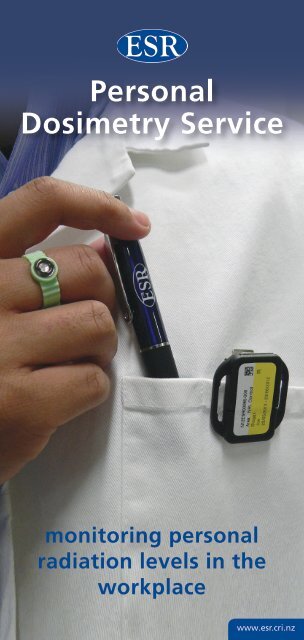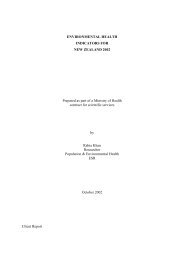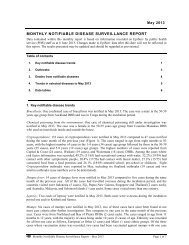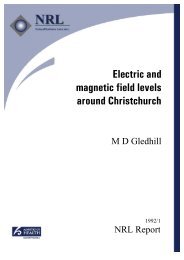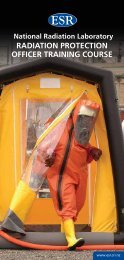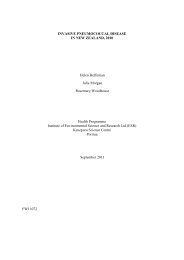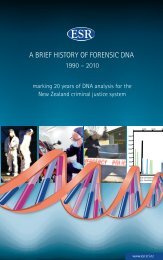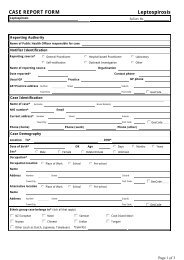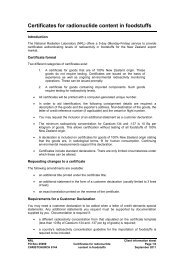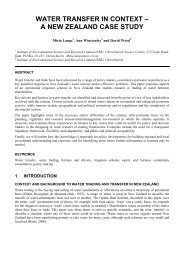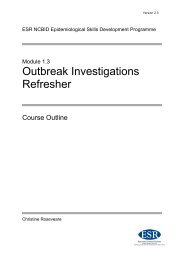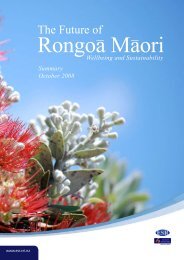brochure - Environmental Science & Research
brochure - Environmental Science & Research
brochure - Environmental Science & Research
You also want an ePaper? Increase the reach of your titles
YUMPU automatically turns print PDFs into web optimized ePapers that Google loves.
Personal<br />
Dosimetry Service<br />
monitoring personal<br />
radiation levels in the<br />
workplace<br />
www.esr.cri.nz
Personal radiation monitoring services<br />
for workplace health and safety<br />
The effects of ionising radiation exposure on the<br />
human body are cumulative. Monitoring individual<br />
exposure to workplace radiation can confirm that<br />
doses are low and recommended dose limits are<br />
not exceeded.<br />
ESR’s Personal Dosimetry Service offers employers a<br />
convenient means to measure and record the radiation doses<br />
employees accumulate at work. The service offers flexibility in<br />
monitoring options.<br />
ESR supports its monitoring service with specialist technical<br />
knowledge and experience gained through its long experience<br />
and broad range of radiation safety activities.<br />
The service has a 60 year history of operation and is the only<br />
service of its kind based entirely in New Zealand.<br />
The National Radiation Laboratory<br />
The National Radiation Laboratory is a specialist unit of The<br />
Institute of <strong>Environmental</strong> <strong>Science</strong> and <strong>Research</strong> Ltd (ESR),<br />
a New Zealand Crown research institute and is based in<br />
Christchurch, New Zealand.<br />
ESR provides expert advice, services and research capability on<br />
public, occupational and medical exposure to radiation, the<br />
performance of radiation equipment and the measurement of<br />
radiation and radioactivity.<br />
ESR has national and international connections with radiation<br />
protection and associated health agencies.
Personal monitoring options<br />
ESR has two personal dosemeters for monitoring different parts<br />
of the body. The PB15T monitor is suitable for measuring doses<br />
to the trunk, limbs, and lens of the eye (or collar) and the ring<br />
monitor is suited to measuring doses to the fingers and hands.<br />
Both dosemeter types were designed for ease of use, sensitivity,<br />
and simplicity in dose assessment.<br />
PB15T<br />
PB15T monitor<br />
The PB15T monitor attaches easily to the outside of clothing<br />
on the trunk, collar, wrist or ankle. The badge has an integrated<br />
clip and a range of other attachment options may be used. The<br />
monitor is labelled with the wearer’s name, wearing position and<br />
wearing period.<br />
This monitor is a universal body monitor and is suitable for all<br />
areas of the body except hands and fingers. Monitoring of the<br />
hand and fingers is best undertaken by a ring dosemeter.<br />
Ring monitor<br />
The ring monitor fits any sized finger and comes in four colours<br />
(indicating month of issue). It has an easy<br />
to read identification number.
ESR’s dosemeter technology<br />
Both dosemeters contain discs of thermoluminescent, tissueequivalent<br />
material. The discs store the radiation energy they<br />
absorb so that it can be measured later in the laboratory.<br />
Measurement results<br />
Results reveal not just whether exposure has occurred, but<br />
how much. The units and quantities used for reporting are<br />
consistent with international guidance and can be compared<br />
safely with limit quantities set in legislation and recommended<br />
by international radiation safety bodies.
Get the right monitoring for your needs<br />
As well as monitoring, analysis, reporting and record keeping,<br />
ESR can provide advice on the right monitoring strategy for<br />
any situation and on the interpretation of your results.<br />
Technical specifications<br />
Radiation type<br />
and energy<br />
Maximum<br />
recommended<br />
wearing period<br />
Photon radiation between 15 keV and 3<br />
MeV<br />
Beta radiation above 0.8 MeV<br />
Three months<br />
Reporting<br />
quantities<br />
Reporting unit<br />
Reporting<br />
resolutions<br />
Dosemeter issue<br />
Reporting<br />
Personal dose equivalent at depths of<br />
10 or 0.07mm, Hp(10) and Hp(0.07)<br />
respectively, as defined by the International<br />
Commission on Radiation Units in report<br />
ICRU 51<br />
Millisievert, mSv<br />
0.01 mSv for Hp(10) and 0.1 mSv for<br />
Hp(0.07) respectively for doses under<br />
1 mSv, and 2 significant figures thereafter<br />
Dosemeters are issued for one, two,<br />
or three months as required. They are<br />
delivered automatically at the start of the<br />
agreed period.<br />
Doses reported using Hp(0.07) may be<br />
compared numerically with equivalent<br />
dose limits set for the skin (500 mSv in<br />
any one year), and Hp(10) for dosemeters<br />
worn at suitable locations on the body,<br />
may be compared with equivalent dose<br />
limits set for the extremities (500 mSv per<br />
year) and the effective dose limit<br />
(20 mSv per year). In most exposure<br />
situations where separate eye monitoring<br />
is used, this is also true when comparing<br />
Hp(10) with the equivalent dose limit for<br />
the lens of the eye (150 mSv per year)
Contact<br />
Personal Dosimetry Service<br />
Phone: +64 3 351 0015<br />
Email: pds@esr.cri.nz<br />
Fax: +64 3 351 0010<br />
National Radiation Laboratory<br />
Institute of <strong>Environmental</strong> <strong>Science</strong><br />
and <strong>Research</strong><br />
27 Creyke Road, Ilam<br />
Christchurch 8041<br />
©<br />
ESR MARCH 2013 WEB<br />
www.esr.cri.nz


